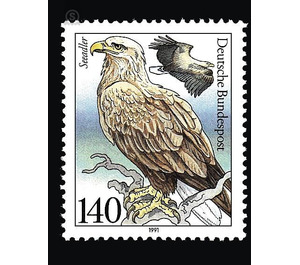Animal welfare - Threatened seabirds - Germany / Federal Republic of Germany 1991 - 140 Pfennig
Theme: Animals
| Country | Germany / Federal Republic of Germany |
| Issue Date | 1991 |
| Face Value | 140.00 |
| Color | multi-colored |
| Perforation | K 13 3/4: 14 |
| Printing Type | 4-color offset printing |
| Stamp Type | Postage stamp |
| Item Type | Stamp |
| Chronological Issue Number | 1415 |
| Chronological Chapter | GER-BRD |
| SID | 814125 |
| In 39 Wishlists | |
The stately white-tailed eagle (total length 570 mm, wingspan 1500 mm) with enormously sized yellow beak is characterized by the white bump (tail) in old age (sexual maturity is reached only at 5 to 6 years!). This magnificent bird of prey occurs in the coastal area and on larger inland waters, reached in Germany - in the north of the new federal states breed just under 100 pairs - its current western distribution limit on the European mainland. He is otherwise in Iceland, in northern and eastern Scandinavia, in the Balkans and from Poland to the east. High up in the trees stand the huge billet nests, which if possible are maintained for many years and are getting bigger and bigger as a result of repair work, which is carried out every year. The clutch consists of 2 white eggs, which are incubated mainly by the female for about 6 weeks. The nestling season lasts just under 3 months, so that at least 5 months elapse from the start of construction until the departure of the young. Sea eagles feed on waterfowl, fish and mammals, often picking up carrion. The prey is hunted from the Ansitz or in the search flight; he attacks ducks, Bleßrallen u. a. directly on the water surface, operated during the fish hunt as a bumpers, hunts for Wegelagerermanier other birds of prey from the prey and robbed of water bird nests. The white-tailed eagle can be a stand bird and a part-puller, but can also go on a long-distance hike like a real migratory bird. (Text: Dr. Joachim Haensel, Tierpark Berlin)


